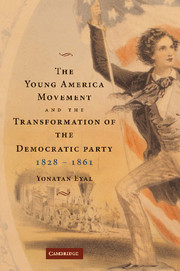Book contents
- Frontmatter
- Contents
- Acknowledgments
- Introduction: The Spirit of Young America
- 1 Orthodox Jacksonianism, 1828–1844
- 2 Trade and Improvements: The Economic Orientation of Young America Democrats
- 3 Rails, Canals, and a New Commercial Spirit
- 4 Young America Democrats and the Revolutions of 1848
- 5 A New International Consciousness
- 6 The Fires of Perfection Revisited
- 7 The Antislavery Democracy
- 8 New Democrats and the Coming of the Civil War
- Conclusion: Lincoln on Young America
- Index
2 - Trade and Improvements: The Economic Orientation of Young America Democrats
Published online by Cambridge University Press: 31 July 2009
- Frontmatter
- Contents
- Acknowledgments
- Introduction: The Spirit of Young America
- 1 Orthodox Jacksonianism, 1828–1844
- 2 Trade and Improvements: The Economic Orientation of Young America Democrats
- 3 Rails, Canals, and a New Commercial Spirit
- 4 Young America Democrats and the Revolutions of 1848
- 5 A New International Consciousness
- 6 The Fires of Perfection Revisited
- 7 The Antislavery Democracy
- 8 New Democrats and the Coming of the Civil War
- Conclusion: Lincoln on Young America
- Index
Summary
In 1860, when Stephen A. Douglas prepared his run for the presidency, he invited New York banker and financier August Belmont to become national chairman of the Democratic Party. Belmont had arrived in the New World barely 20 years earlier, at age 24, and now he was helping to run the campaign of the Democracy's most prominent leader. As a representative of the Rothschild family in New York, and as one of America's richest men during the nineteenth century, Belmont symbolized the East Coast establishment, or what Jacksonians loved to call the “money power.” Yet he remained a staunch Democrat throughout his life, never wavering in his commitment to the coalition established by Old Hickory in the 1820s and 1830s. How could someone so seemingly un-Jacksonian fit so well within the leadership of the antebellum Democratic Party?
The answer is Young America. On the eve of the Civil War, the Democracy no longer stood for the same economic policies, no longer defended the same outlook, that had dominated its heyday of the 1830s. Between the time when Andrew Jackson and Martin Van Buren served as the leading Democratic icons and the moment when Stephen A. Douglas and August Belmont took their places, an important transformation altered the core of Democratic ideology.
This chapter will address the economic orientation of Young America Democrats. What beliefs about commerce and finance transformed the party of Jackson and Van Buren into the party of Douglas and Belmont?
- Type
- Chapter
- Information
- Publisher: Cambridge University PressPrint publication year: 2007



